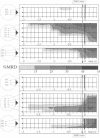Abstract
OBJECTIVE--To study planning of movement in Parkinson's disease. METHODS--The spatiotemporal pattern of movement related desynchronisation (MRD) preceding a self paced voluntary wrist flexion was compared between two groups of 10 untreated right and left hemiparkinsonian patients receiving no treatment and 10 control subjects. The MRD was computed in the 9 to 11 Hz frequency band from 11 source derivations covering the frontocentral, central, and parietocentral areas, during two successive left and right experimental conditions. RESULTS--In the two patient groups the desynchronisation appeared over the primary sensorimotor area contralateral to the affected side with a shorter latency (750 ms before movement onset for the right hemiparkinsonian group and 875 ms for the left hemiparkinsonian group) than in the control group (1750 ms), only when the movements were performed with the akinetic hand. For the non-affected hand, the same latency as in the control group was noted (1750 ms). CONCLUSION--The delay of appearance of MRD in Parkinson's disease confirmed that the programming of movement is affected, thus partially explaining akinesia.
Full text
PDF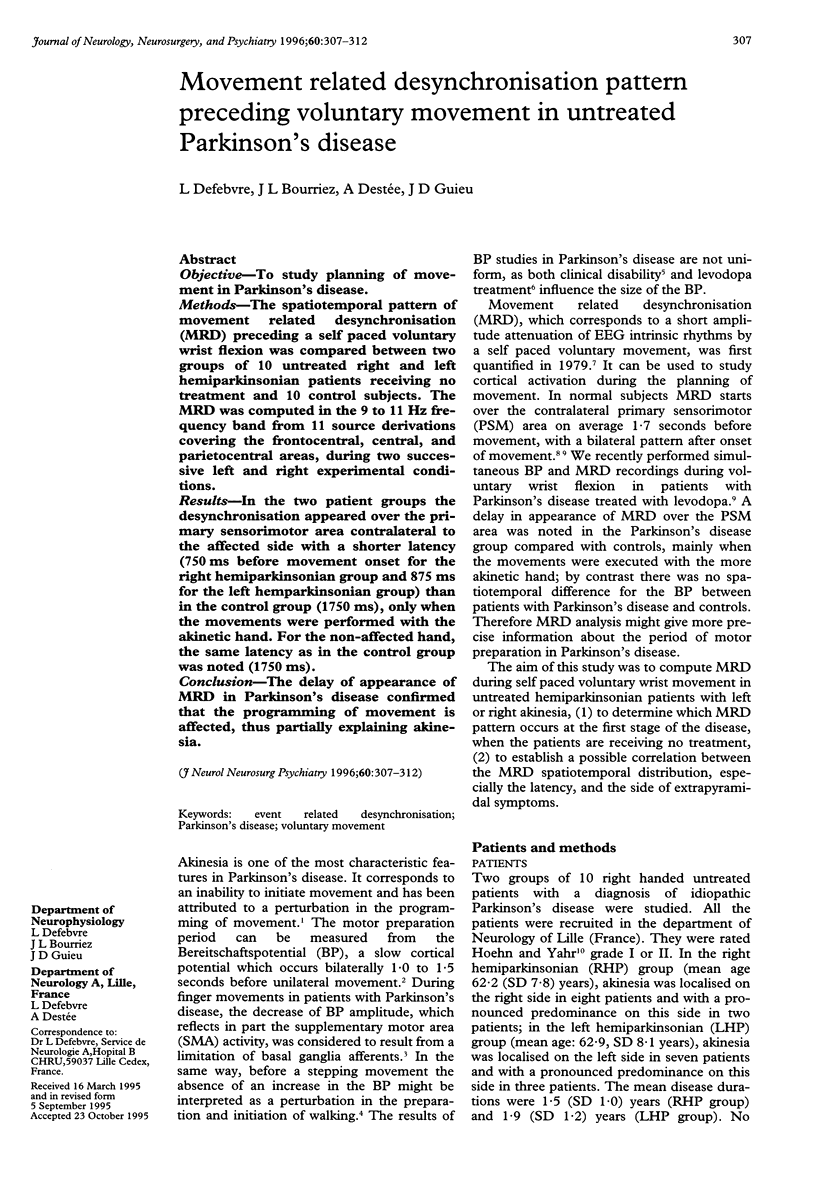
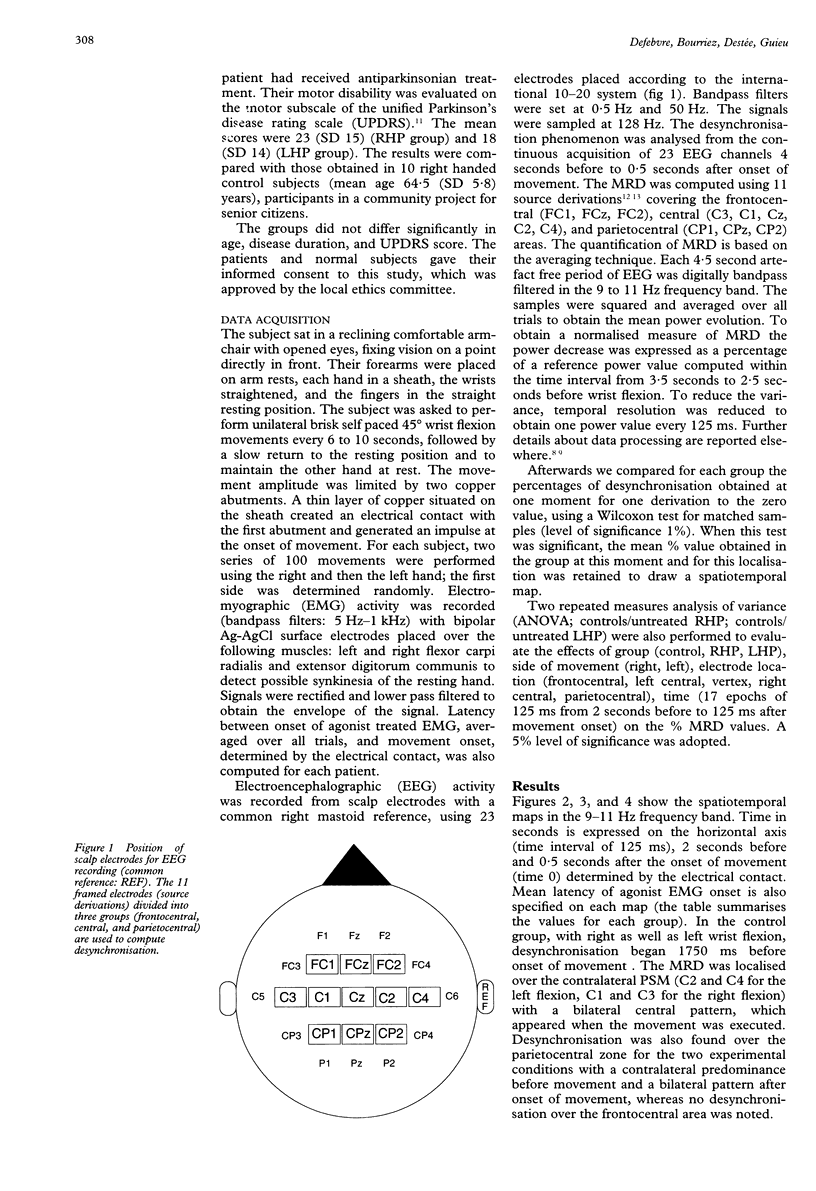
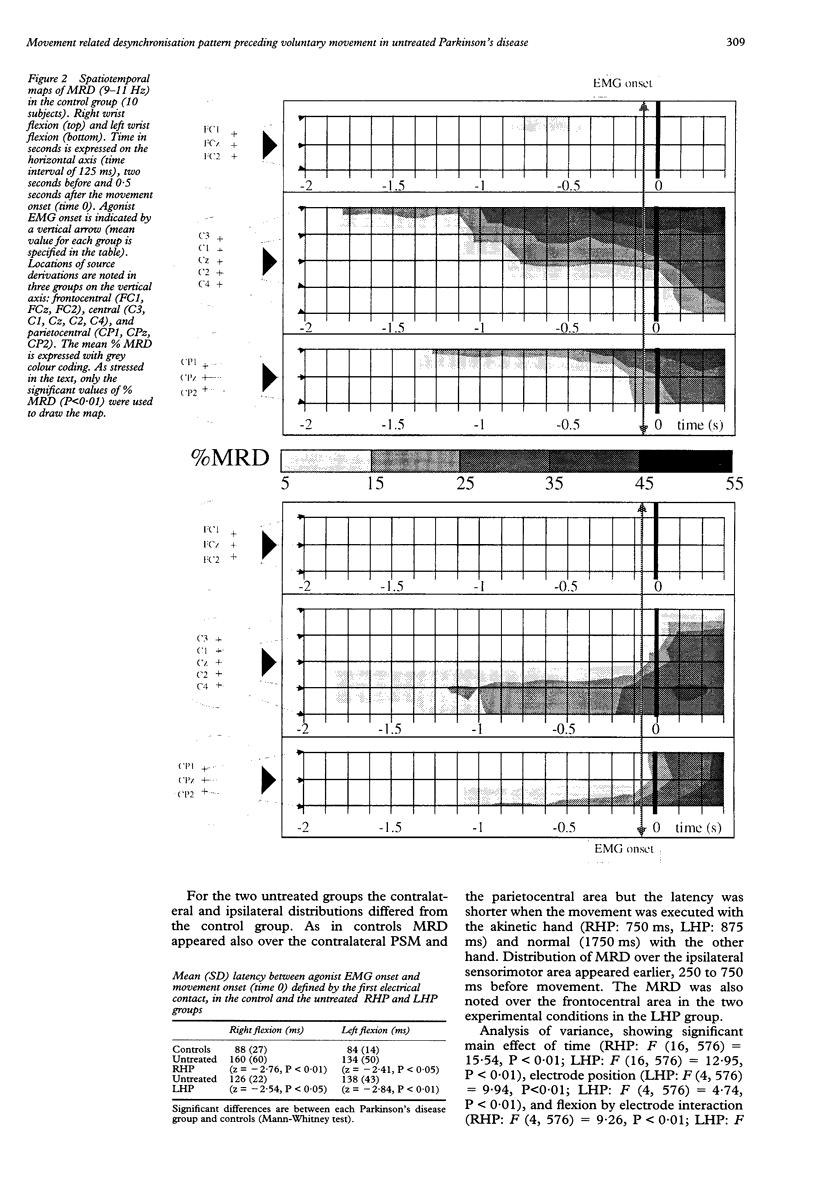
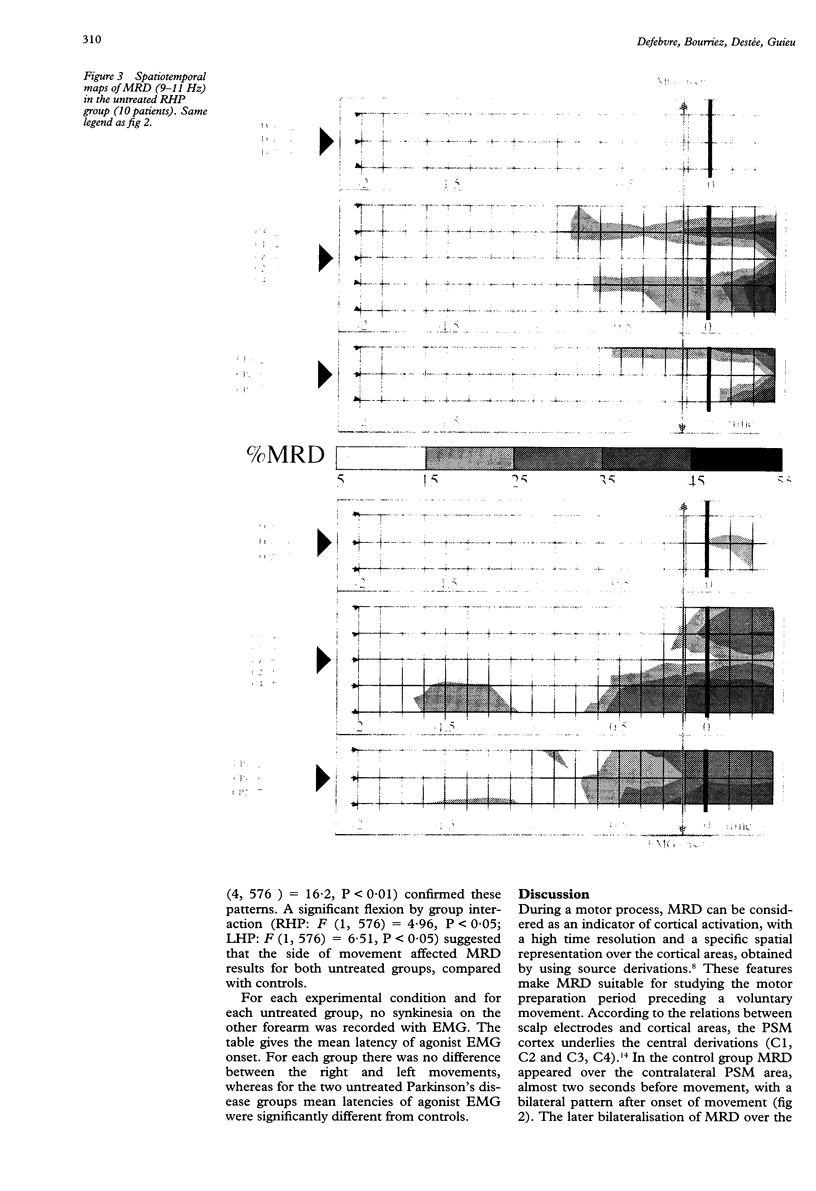
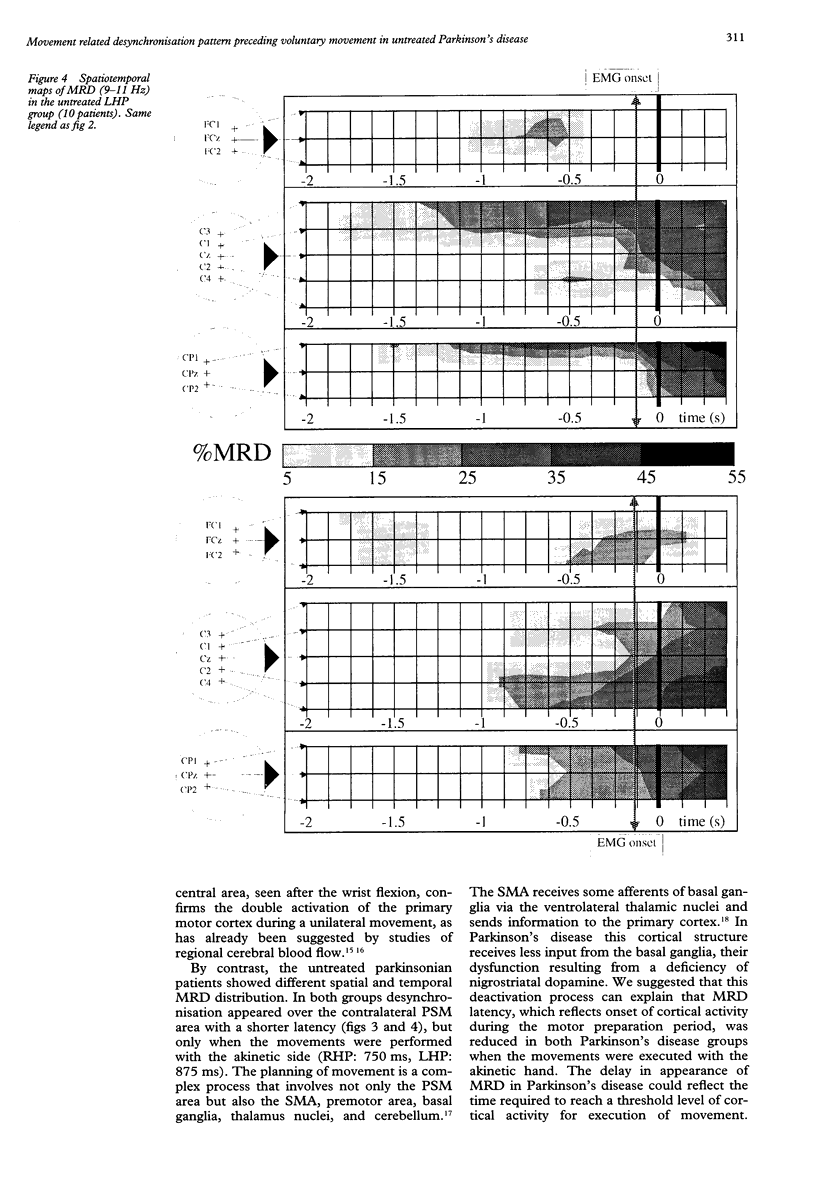
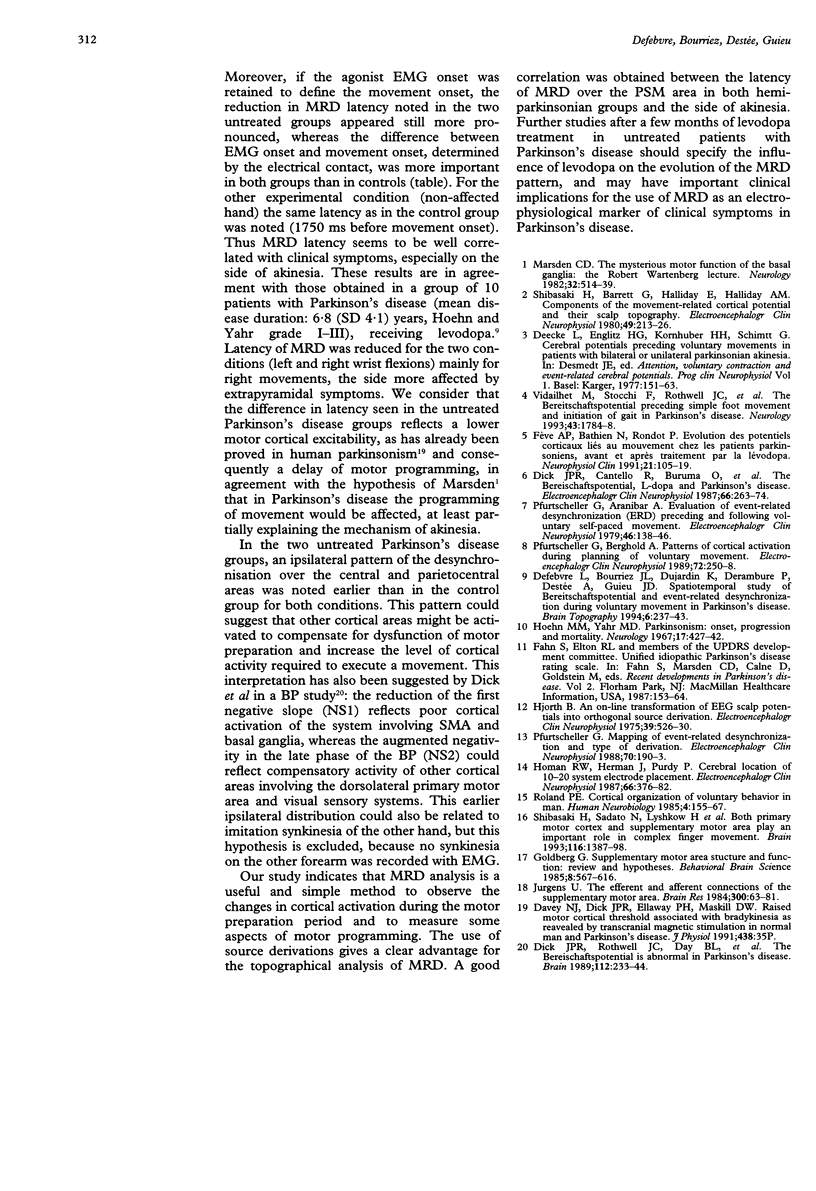
Images in this article
Selected References
These references are in PubMed. This may not be the complete list of references from this article.
- Defebvre L., Bourriez J. L., Dujardin K., Derambure P., Destée A., Guieu J. D. Spatiotemporal study of Bereitschaftspotential and event-related desynchronization during voluntary movement in Parkinson's disease. Brain Topogr. 1994 Spring;6(3):237–244. doi: 10.1007/BF01187715. [DOI] [PubMed] [Google Scholar]
- Dick J. P., Cantello R., Buruma O., Gioux M., Benecke R., Day B. L., Rothwell J. C., Thompson P. D., Marsden C. D. The Bereitschaftspotential, L-DOPA and Parkinson's disease. Electroencephalogr Clin Neurophysiol. 1987 Mar;66(3):263–274. doi: 10.1016/0013-4694(87)90075-7. [DOI] [PubMed] [Google Scholar]
- Dick J. P., Rothwell J. C., Day B. L., Cantello R., Buruma O., Gioux M., Benecke R., Berardelli A., Thompson P. D., Marsden C. D. The Bereitschaftspotential is abnormal in Parkinson's disease. Brain. 1989 Feb;112(Pt 1):233–244. doi: 10.1093/brain/112.1.233. [DOI] [PubMed] [Google Scholar]
- Hjorth B. An on-line transformation of EEG scalp potentials into orthogonal source derivations. Electroencephalogr Clin Neurophysiol. 1975 Nov;39(5):526–530. doi: 10.1016/0013-4694(75)90056-5. [DOI] [PubMed] [Google Scholar]
- Hoehn M. M., Yahr M. D. Parkinsonism: onset, progression and mortality. Neurology. 1967 May;17(5):427–442. doi: 10.1212/wnl.17.5.427. [DOI] [PubMed] [Google Scholar]
- Homan R. W., Herman J., Purdy P. Cerebral location of international 10-20 system electrode placement. Electroencephalogr Clin Neurophysiol. 1987 Apr;66(4):376–382. doi: 10.1016/0013-4694(87)90206-9. [DOI] [PubMed] [Google Scholar]
- Jürgens U. The efferent and afferent connections of the supplementary motor area. Brain Res. 1984 May 21;300(1):63–81. doi: 10.1016/0006-8993(84)91341-6. [DOI] [PubMed] [Google Scholar]
- Marsden C. D. The mysterious motor function of the basal ganglia: the Robert Wartenberg Lecture. Neurology. 1982 May;32(5):514–539. doi: 10.1212/wnl.32.5.514. [DOI] [PubMed] [Google Scholar]
- Pfurtscheller G., Aranibar A. Evaluation of event-related desynchronization (ERD) preceding and following voluntary self-paced movement. Electroencephalogr Clin Neurophysiol. 1979 Feb;46(2):138–146. doi: 10.1016/0013-4694(79)90063-4. [DOI] [PubMed] [Google Scholar]
- Pfurtscheller G., Berghold A. Patterns of cortical activation during planning of voluntary movement. Electroencephalogr Clin Neurophysiol. 1989 Mar;72(3):250–258. doi: 10.1016/0013-4694(89)90250-2. [DOI] [PubMed] [Google Scholar]
- Pfurtscheller G. Mapping of event-related desynchronization and type of derivation. Electroencephalogr Clin Neurophysiol. 1988 Aug;70(2):190–193. doi: 10.1016/0013-4694(88)90119-8. [DOI] [PubMed] [Google Scholar]
- Roland P. E. Cortical organization of voluntary behavior in man. Hum Neurobiol. 1985;4(3):155–167. [PubMed] [Google Scholar]
- Shibasaki H., Barrett G., Halliday E., Halliday A. M. Components of the movement-related cortical potential and their scalp topography. Electroencephalogr Clin Neurophysiol. 1980 Aug;49(3-4):213–226. doi: 10.1016/0013-4694(80)90216-3. [DOI] [PubMed] [Google Scholar]
- Shibasaki H., Sadato N., Lyshkow H., Yonekura Y., Honda M., Nagamine T., Suwazono S., Magata Y., Ikeda A., Miyazaki M. Both primary motor cortex and supplementary motor area play an important role in complex finger movement. Brain. 1993 Dec;116(Pt 6):1387–1398. doi: 10.1093/brain/116.6.1387. [DOI] [PubMed] [Google Scholar]
- Vidailhet M., Stocchi F., Rothwell J. C., Thompson P. D., Day B. L., Brooks D. J., Marsden C. D. The Bereitschaftspotential preceding simple foot movement and initiation of gait in Parkinson's disease. Neurology. 1993 Sep;43(9):1784–1788. doi: 10.1212/wnl.43.9.1784. [DOI] [PubMed] [Google Scholar]



